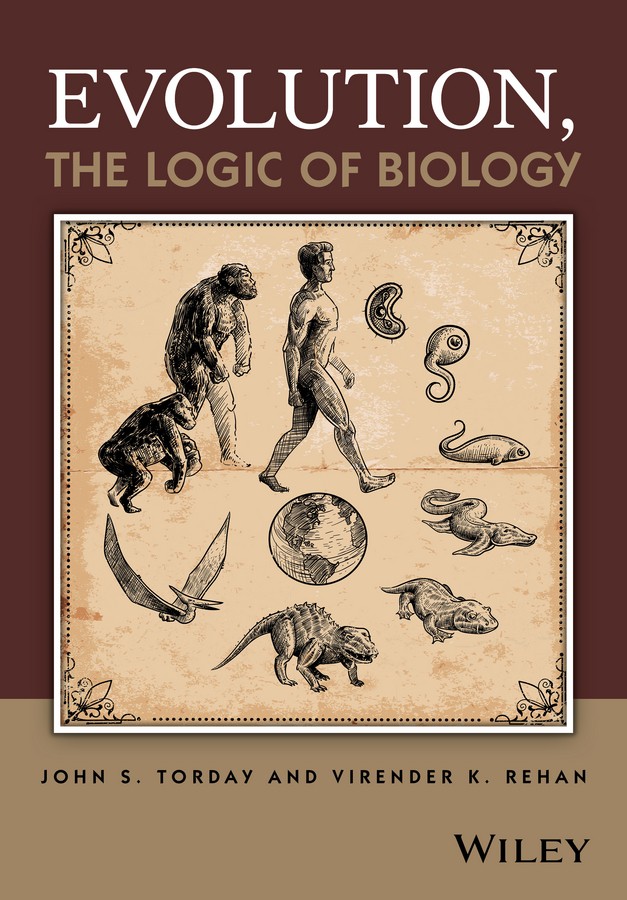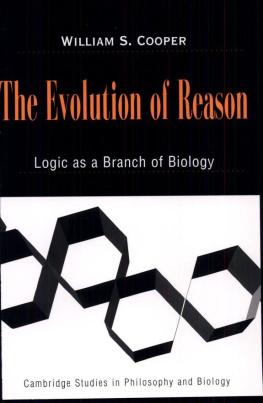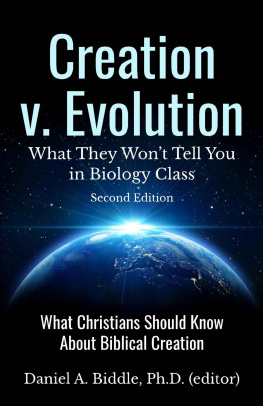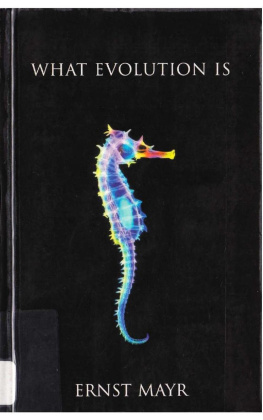John S. Torday - Evolution, the Logic of Biology
Here you can read online John S. Torday - Evolution, the Logic of Biology full text of the book (entire story) in english for free. Download pdf and epub, get meaning, cover and reviews about this ebook. year: 2017, genre: Romance novel. Description of the work, (preface) as well as reviews are available. Best literature library LitArk.com created for fans of good reading and offers a wide selection of genres:
Romance novel
Science fiction
Adventure
Detective
Science
History
Home and family
Prose
Art
Politics
Computer
Non-fiction
Religion
Business
Children
Humor
Choose a favorite category and find really read worthwhile books. Enjoy immersion in the world of imagination, feel the emotions of the characters or learn something new for yourself, make an fascinating discovery.

- Book:Evolution, the Logic of Biology
- Author:
- Genre:
- Year:2017
- Rating:5 / 5
- Favourites:Add to favourites
- Your mark:
- 100
- 1
- 2
- 3
- 4
- 5
Evolution, the Logic of Biology: summary, description and annotation
We offer to read an annotation, description, summary or preface (depends on what the author of the book "Evolution, the Logic of Biology" wrote himself). If you haven't found the necessary information about the book — write in the comments, we will try to find it.
Evolution, the Logic of Biology — read online for free the complete book (whole text) full work
Below is the text of the book, divided by pages. System saving the place of the last page read, allows you to conveniently read the book "Evolution, the Logic of Biology" online for free, without having to search again every time where you left off. Put a bookmark, and you can go to the page where you finished reading at any time.
Font size:
Interval:
Bookmark:

- Chapter 13
- Chapter 01
- Chapter 02
- Chapter 03
- Chapter 04
- Chapter 05
- Chapter 06
- Chapter 08
- Chapter 09
- Chapter 11
- Chapter 12
- Chapter 13
- Chapter 14
- Chapter 15
- Chapter 17
- Chapter 18
- Chapter 19
- Chapter 20
John S. Torday
Departments of Pediatrics, and Obstetrics and Gynecology
HarborUCLA Medical Center, Torrance, California, USA
Evolutionary Medicine Program
UCLA, Los Angeles, California, USA
Virender K. Rehan
Department of Pediatrics
HarborUCLA Medical Center
Torrance, California, USA

This edition first published 2017
2017 John Wiley & Sons, Inc.
All rights reserved. No part of this publication may be reproduced, stored in a retrieval system, or transmitted, in any form or by any means, electronic, mechanical, photocopying, recording or otherwise, except as permitted by law. Advice on how to obtain permission to reuse material from this title is available at http://www.wiley.com/go/permissions.
The right of John S. Torday and Virender K. Rehan to be identified as the authors of this work has been asserted in accordance with law.
Registered Office
John Wiley & Sons, Inc., 111 River Street, Hoboken, NJ 07030, USA
Editorial Office
111 River Street, Hoboken, NJ 07030, USA
For details of our global editorial offices, customer services, and more information about Wiley products visit us at www.wiley.com.
Wiley also publishes its books in a variety of electronic formats and by printondemand. Some content that appears in standard print versions of this book may not be available in other formats.
Limit of Liability/Disclaimer of Warranty
The publisher and the authors make no representations or warranties with respect to the accuracy or completeness of the contents of this work and specifically disclaim all warranties; including without limitation any implied warranties of fitness for a particular purpose. This work is sold with the understanding that the publisher is not engaged in rendering professional services. The advice and strategies contained herein may not be suitable for every situation. In view of ongoing research, equipment modifications, changes in governmental regulations, and the constant flow of information relating to the use of experimental reagents, equipment, and devices, the reader is urged to review and evaluate the information provided in the package insert or instructions for each chemical, piece of equipment, reagent, or device for, among other things, any changes in the instructions or indication of usage and for added warnings and precautions. The fact that an organization or website is referred to in this work as a citation and/or potential source of further information does not mean that the author or the publisher endorses the information the organization or website may provide or recommendations it may make. Further, readers should be aware that websites listed in this work may have changed or disappeared between when this works was written and when it is read. No warranty may be created or extended by any promotional statements for this work. Neither the publisher nor the author shall be liable for any damages arising here from.
Library of Congress CataloguinginPublication data applied for
ISBN: 9781118729267
Cover design: Wiley
Cover image: Man_Halftube/Gettyimages
Dr. Torday dedicates this book to his wife Barbara, his children Nicole Anne and Daniel Philip Torday, his daughterinlaw Dr. Erin Kathleen Torday, his granddaughters Abigail Eve and Delia Rose Torday, his parents Steven and Maria Torday, and his mentor Mary Ellen Avery.
Dr. Rehan dedicates this book to his parents Sain Das and Nirmala Rehan, his wife Yu Hsiu and children Amit and Anika Rehan, and his brother (the late) Dr. Sudhir Rehan.
We shall not cease from exploration
and the end of all our exploring will be
to arrive where we started
and know the place for the first time.
T.S. Eliot, Four Quartets
This book is a sequel to our first publication on the cellularmolecular basis for vertebrate evolution, which was entitled Evolutionary Biology, CellCell Communication, and Complex Disease. In it we showed the utility of a cellularmolecular approach to understanding the evolution of complex physiology from the unicellular state. In the current book, the Ur hypothesis is that all complex physiology has evolved from the cell membrane of unicellular organisms, offering a functional integration of all physiologic properties intersecting structurally and functionally in the unicellular singularity. This combined holisticreductionistic perspective provides a fundamental insight to the logic of biology never before available.
By tracing the emergence and contingence of novel evolutionary traits backwards in the history of the organism using ontogeny and phylogeny as guide posts, we have been able to deconvolute the lung as an archetype for understanding how and why physiologic traits have evolved from their unicellular origins how cholesterol evolved from the sterol pathway of bacteria to facilitate oxygenation, metabolism, and locomotion in primitive eukaryotes, only to later recur molecularly, cellularly, structurally, and functionally as the swim bladder of fish, and subsequently as the lung of amphibians, reptiles, mammals, and birds. That arc has provided a way of connecting the evolutionary dots to other physiologic traits skin, kidney, skeleton, brain by tracing their evolution in tandem with the lung ontogenetically and phylogenetically, in combination with pathophysiologic data to provide the fullest picture for such complex, arcane interrelationships. Such interconnections become more apparent during times of stress like the watertoland transition (see , e.g.). The specific causes of the gene mutations and duplications that occurred during that phase of vertebrate evolution, when seen in the context of having to adapt to terrestrial life, become selfevident when factored into the prevailing physiologic constraints. This is particularly true of the developmental and phylogenetic properties that are mediated by soluble growth factors and their cognate receptors.
In brief, , entitled MetaDarwinism, provides examples of the power of the cellularmolecular approach to evolution.
The content of this book constitutes a novel, mechanistic, testable, refutable approach to the questions of how and why evolution has occurred. This book is dedicated to that sea change.
John S. Torday
Virender K. Rehan
Introduction
There are these two young fish swimming along, and they happen to meet an older fish swimming the other way, who nods at them and says, Morning, boys. How's the water? And the two young fish swim on for a bit, and then eventually one of them looks over at the other and goes "What the hell is water?"
David Foster Wallace, Kenyon College Commencement Speech, 2005
The premise of this book is that the Big Bang of the Universe gave rise to inorganic and organic compounds alike. Both are formed by bonds, the former constituted by inertness, the latter doing quite the opposite by giving rise to life itself. Organic chemistry provided the physical space within which negentropy, chemiosmosis, and homeostasis all acted in concert to form the first primitive cells. Singlecelled organisms dominated the Earth for the first 3 or 4 billion years, followed by the generation of multicellular organisms as exaptations. How and why this occurred provides the mechanism for the emergence of human biology, starting with the first principles of physiology. Such a rendering is way overdue, since the human genome was published more than a decade and a half ago. Without such an effectively predictive working model for physiology, such information is of little value.
Next pageFont size:
Interval:
Bookmark:
Similar books «Evolution, the Logic of Biology»
Look at similar books to Evolution, the Logic of Biology. We have selected literature similar in name and meaning in the hope of providing readers with more options to find new, interesting, not yet read works.
Discussion, reviews of the book Evolution, the Logic of Biology and just readers' own opinions. Leave your comments, write what you think about the work, its meaning or the main characters. Specify what exactly you liked and what you didn't like, and why you think so.





